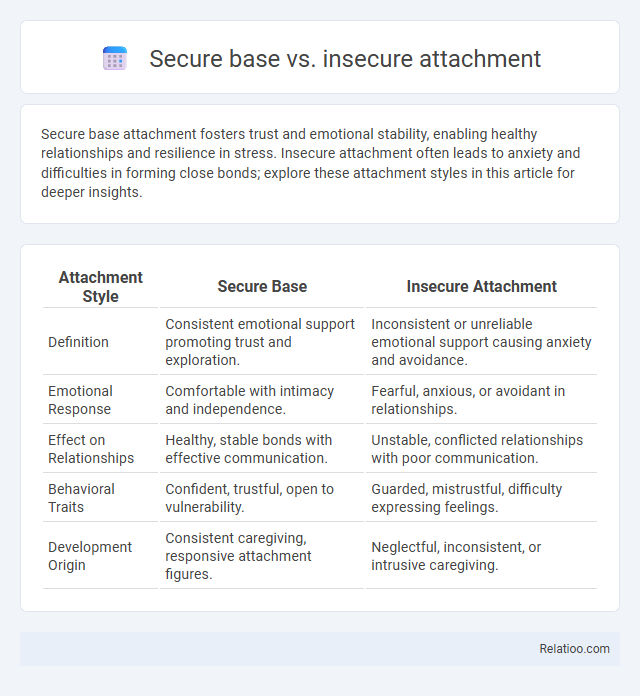Secure base attachment fosters trust and emotional stability, enabling healthy relationships and resilience in stress. Insecure attachment often leads to anxiety and difficulties in forming close bonds; explore these attachment styles in this article for deeper insights.
Table of Comparison
| Attachment Style | Secure Base | Insecure Attachment |
|---|---|---|
| Definition | Consistent emotional support promoting trust and exploration. | Inconsistent or unreliable emotional support causing anxiety and avoidance. |
| Emotional Response | Comfortable with intimacy and independence. | Fearful, anxious, or avoidant in relationships. |
| Effect on Relationships | Healthy, stable bonds with effective communication. | Unstable, conflicted relationships with poor communication. |
| Behavioral Traits | Confident, trustful, open to vulnerability. | Guarded, mistrustful, difficulty expressing feelings. |
| Development Origin | Consistent caregiving, responsive attachment figures. | Neglectful, inconsistent, or intrusive caregiving. |
Understanding Attachment Theory
Secure base in attachment theory refers to a caregiver's reliable presence that provides a child with safety and confidence to explore their environment. Insecure attachment occurs when this base is inconsistent or unresponsive, leading to anxiety, avoidance, or ambivalence in the child's relationships. Understanding attachment theory highlights how secure base experiences shape emotional regulation and interpersonal trust throughout life.
What Is a Secure Base in Relationships?
A secure base in relationships refers to a trusted partner who provides emotional support, safety, and encouragement, enabling individuals to explore the world and face challenges confidently. Secure attachment, characterized by consistent responsiveness and reliability, fosters a secure base that promotes healthy emotional regulation and intimate connection. Conversely, insecure attachment, marked by anxiety or avoidance, undermines the formation of a secure base, resulting in difficulties with trust, dependence, and emotional resilience.
Defining Insecure Attachment Styles
Insecure attachment styles are characterized by inconsistent or unresponsive caregiving, leading to difficulties in forming trusting relationships and regulating emotions. These styles include anxious attachment, marked by fear of abandonment and clinginess; avoidant attachment, defined by emotional distancing and self-reliance; and disorganized attachment, which involves a mix of anxiety and avoidance often resulting from trauma or neglect. Understanding these insecure attachment patterns is crucial for addressing relational challenges and fostering psychological resilience.
Key Differences Between Secure and Insecure Attachment
Secure attachment is characterized by consistent caregiver responsiveness, fostering trust and emotional regulation, while insecure attachment often results from inconsistent or neglectful caregiving, leading to anxiety and avoidance in relationships. Children with a secure base feel safe exploring their environment and seeking comfort when distressed, whereas those with insecure attachment may exhibit clinginess, withdrawal, or difficulty in managing stress. The key differences lie in the quality of emotional bonds, with secure attachment promoting resilience and healthy social development, contrasted by insecure attachment's association with emotional challenges and relational difficulties.
Signs of Secure Attachment in Children and Adults
Signs of secure attachment in children include seeking comfort from caregivers when distressed, displaying trust, and showing confidence in exploring their environment. Adults with secure attachment tend to form healthy, trusting relationships, effectively regulate emotions, and communicate openly. Both children and adults with secure attachment demonstrate resilience, empathy, and a balanced sense of autonomy and connectedness.
Common Traits of Insecure Attachment
Insecure attachment is characterized by anxiety, avoidance, and inconsistent responses to caregivers, which often lead to difficulties in trust and emotional regulation. Individuals with insecure attachment may exhibit clinginess, withdrawal, or ambivalence in relationships, reflecting their lack of a reliable secure base. This contrasts with a secure base, where consistent caregiver support fosters confidence, emotional stability, and healthy interpersonal connections.
How Secure Bases Foster Emotional Resilience
Secure bases provide consistent emotional support, enabling individuals to explore their environment confidently while knowing they can return to safety. Insecure attachment often leads to anxiety or avoidance, hindering emotional resilience and vulnerability in relationships. The presence of a secure base fosters self-regulation, stress management, and healthy coping mechanisms essential for long-term emotional well-being.
Impacts of Insecure Attachment on Development
Insecure attachment during early childhood can lead to difficulties in emotional regulation, social relationships, and cognitive development, increasing vulnerability to anxiety and depression. Your ability to form trusting relationships may be impaired, affecting long-term mental health and interpersonal functioning. Understanding the critical role of a secure base is essential in fostering resilience and healthy psychological growth.
Strategies to Cultivate a Secure Attachment
Cultivating a secure attachment involves consistent emotional responsiveness, where caregivers provide a reliable secure base that fosters trust and exploration. Your approach should emphasize sensitivity to the child's needs, offering comfort and encouragement to help regulate emotions and build confidence. Establishing routines and open communication also strengthens secure bonds, reducing the risk of insecure attachment patterns that hinder emotional development.
Healing and Overcoming Insecure Attachment Patterns
Healing insecure attachment patterns involves fostering a secure base through consistent emotional availability and responsiveness, creating a foundation of trust and safety. Therapeutic approaches such as attachment-based therapy, mindfulness, and emotion regulation techniques help individuals reframe negative beliefs and develop healthier relational patterns. Overcoming insecure attachment leads to enhanced emotional resilience, improved self-esteem, and the capacity for meaningful, secure relationships.

Infographic: Secure base vs Insecure attachment
 relatioo.com
relatioo.com